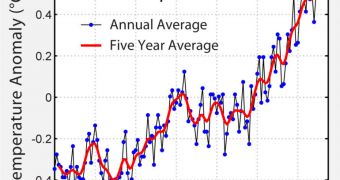The contents of a new scientific study show that average global temperatures could soar by as much as 4°Celsius within the next half-decade, if the business-as-usual economic model is maintained.
At this point in time, limiting greenhouse gas (GHG) emissions should be on the top of the international political agenda. Over the past couple of years however, states have been dragging their feet, refusing to take any kind of responsibility for the environment.
On the other hand, time is indeed running out, and scientists are beginning to attract the attention of politicians increasingly often as to the threats brought on by climate change and global warming.
According to the scientific consensus on our planet's climate, temperature increases need to be kept below a 2-degree Celsius rise from pre-industrial times in the coming future.
In order for that to happen, governments need to pledge significant reductions in GHG emissions, including methane and carbon dioxide (CO2), which frankly seems unlikely to happen soon.
For the foreseeable future, a 4-degree rise in the next 50 years is not our of the question, but may even become likely, if the current emissions trend continues. The conclusion belongs to a new study.
If this scenario materializes, then our planet is in grave danger. Droughts, floods, shifts in crop cycles, peculiar weather patterns, changes in species' habitable zones, glacier meltdowns, sea level rise and increased overall temperatures are only a few of the consequences of misaddressed climate change.
But political leaders such as those meeting in Cancun, Mexico at the UN's COP16, tend to focus on absurd political objectives, such as devising a treaty that would go into effect starting 2020, or maybe even 2050. This is clearly suicide.
“But Mother Nature doesn’t care about what we emit in any particular year. What matters is cumulative carbon emissions,” says Oxford University atmospheric physicist Niel Bowerman, quoted by Science News.
The new report shows that the world needs to emit less than 1 trillion tons of CO2 by 2200, in order to avoid a 2-degree increase in temperature. The bad news? “We’re just over halfway there,” the expert says.
At this point, things are looking rather bleak. Countries need to cap their emissions by 2020 at the latest. That is to say, this is when peak emission levels are reached. It should all be downhill from there.
However, that is unlikely to happen. The most plausible scenario is countries as China and India, Brazil and Australia continue to develop and pollute, while industrial such as juggernauts such as the US and the UK will maintain their high emissions levels as well.

 14 DAY TRIAL //
14 DAY TRIAL //